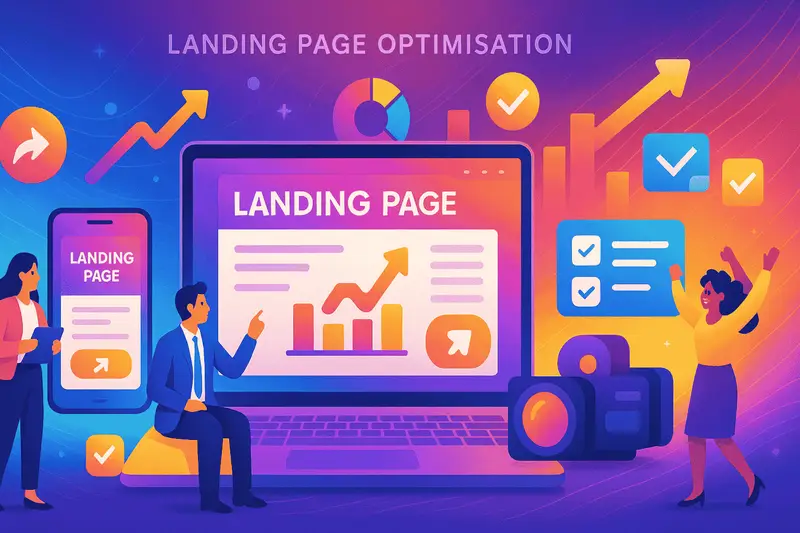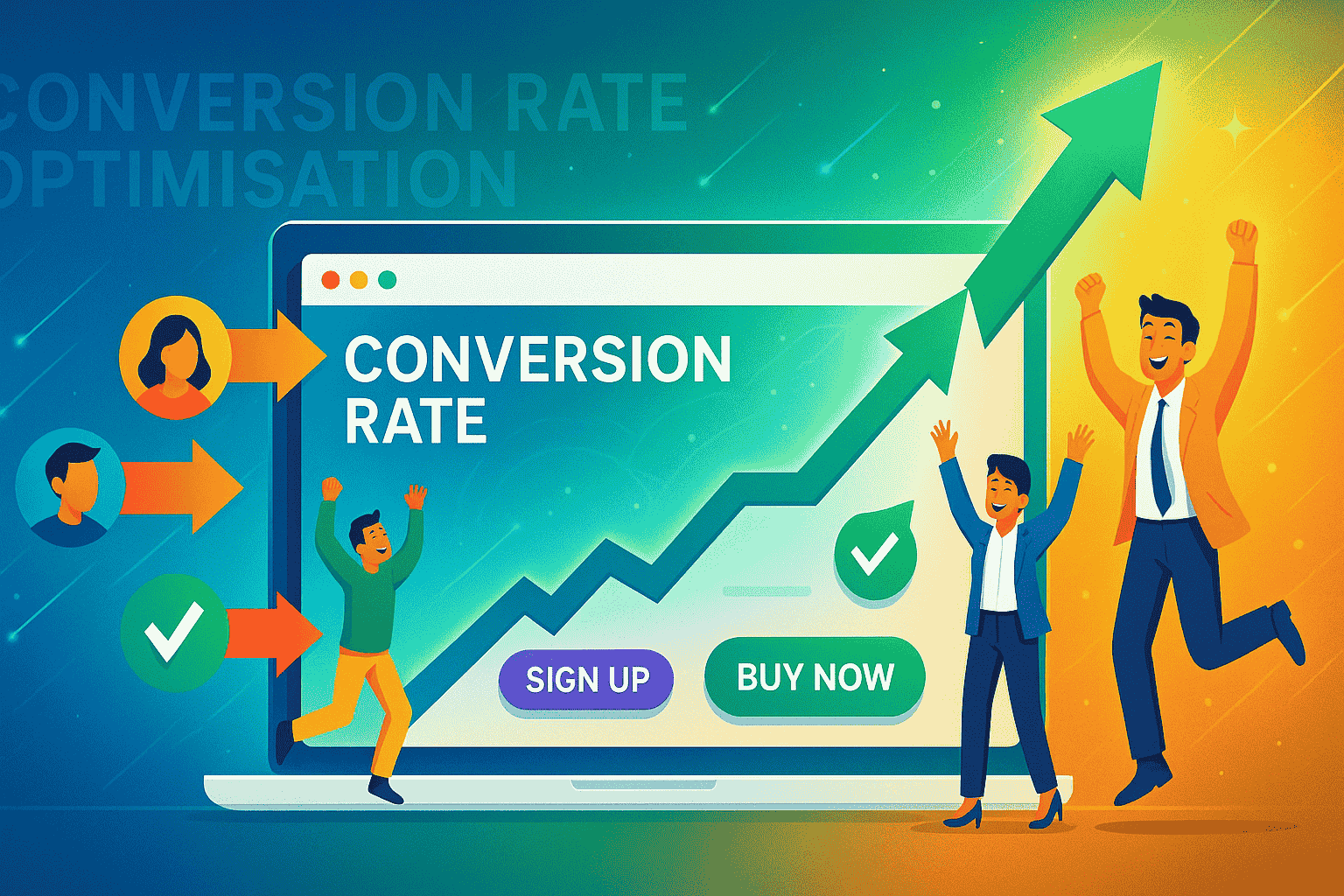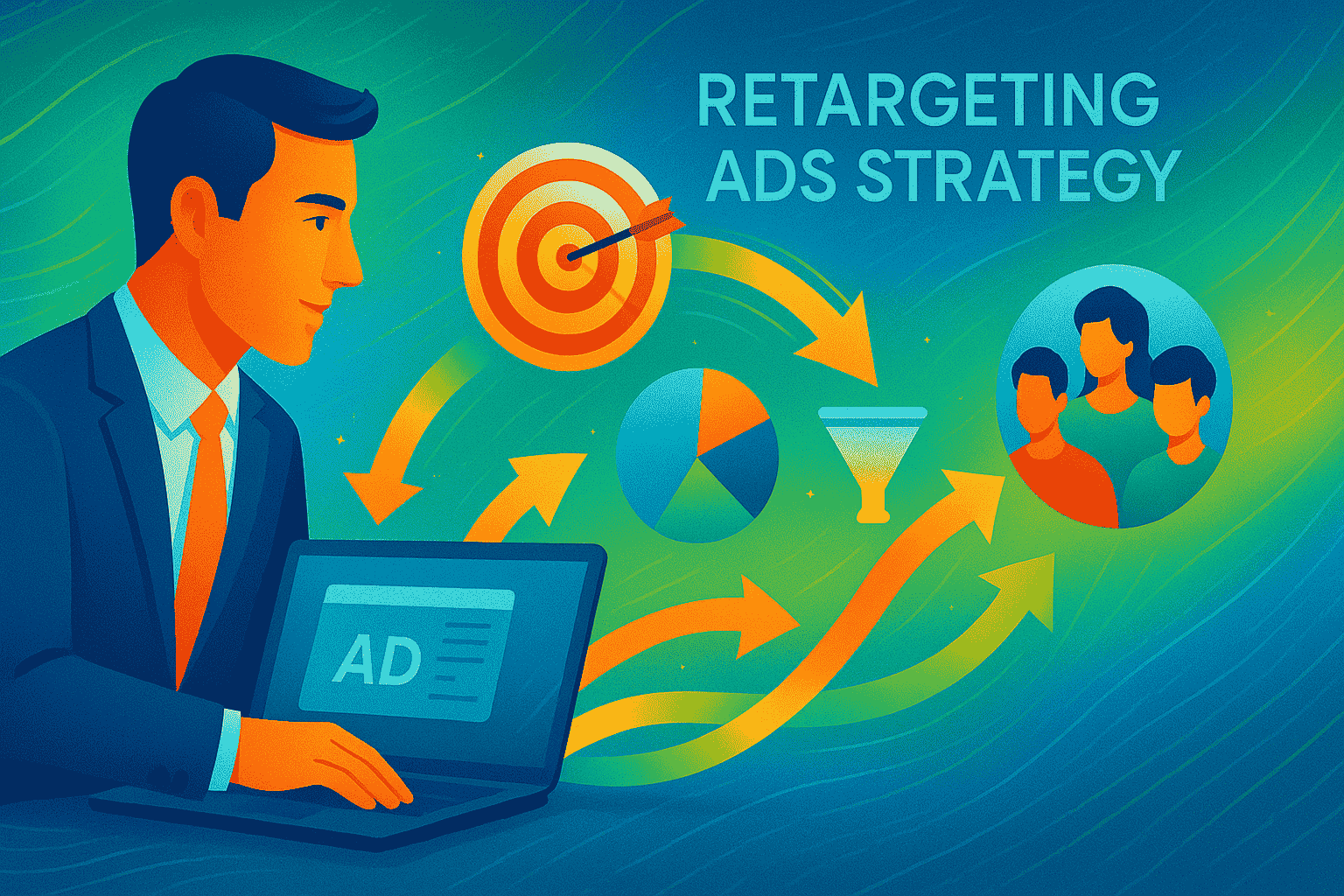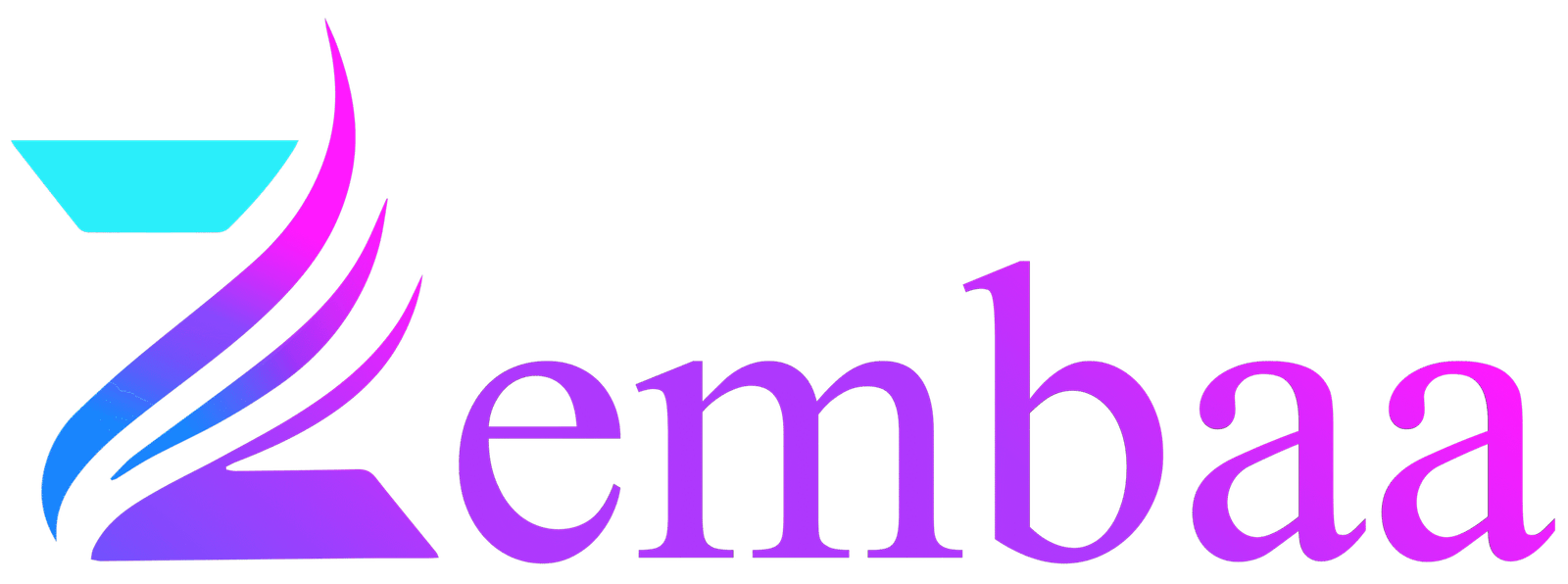Conversion rate optimisation (CRO) is the secret sauce behind every successful digital marketing campaign in 2025. You can drive all the traffic in the world to your website, but if you’re not converting those clicks into customers, you’re leaving money on the table. The good news? With the right CRO strategies, you can dramatically increase your ROI, lower your acquisition costs, and grow your business faster than ever.
This ultimate guide will show you how to master conversion rate optimisation—from landing page design and copywriting to analytics, A/B testing, and advanced tactics. Whether you’re a marketer, entrepreneur, or agency, these strategies will help you turn more visitors into leads, sales, and loyal customers.
What is Conversion Rate Optimisation?
Conversion rate optimisation is the process of improving your website, landing pages, and marketing funnels to increase the percentage of visitors who take a desired action—such as making a purchase, signing up for a newsletter, or requesting a demo.
Key elements of conversion rate optimisation:
- Analyzing user behavior and data
- Testing and refining page elements (headlines, CTAs, forms, etc.)
- Improving user experience (UX) and reducing friction
- Personalizing content and offers
- Measuring and iterating for continuous improvement
Conversion Rate Formula:
Conversion Rate = (Number of Conversions / Total Visitors) x 100
Why Conversion Rate Optimisation Matters in 2025
The digital landscape is more competitive than ever. Here’s why conversion rate optimisation is essential:
- Rising ad costs: Every click is more expensive—make them count.
- Short attention spans: You have seconds to capture interest and drive action.
- Mobile-first world: Most visitors are on smartphones.
- Personalisation: Users expect relevant, tailored experiences.
- Data-driven marketing: CRO delivers measurable ROI and growth.
According to WordStream, the average website conversion rate is just 2.35%. Top performers, however, achieve 5%–11% or more—thanks to conversion rate optimisation.
7 Steps to Master Conversion Rate Optimisation
1. Set Clear Goals and KPIs
Start with your business objectives. What do you want to achieve?
- Increase sales or signups
- Generate more leads
- Lower cost per acquisition (CPA)
- Improve customer retention
KPIs to track:
- Conversion rate
- Bounce rate
- Average order value (AOV)
- Customer lifetime value (CLV)
- Return on ad spend (ROAS)
Action Step:
Write down your top 2–3 goals and how you’ll measure success.
2. Analyze User Behavior and Data
Use analytics to understand how visitors interact with your site:
- Where do they drop off?
- Which pages have the highest exit rates?
- What devices and browsers are they using?
- How long do they stay on each page?
Tools to use:
- Google Analytics 4
- Hotjar or Crazy Egg (heatmaps, session recordings)
- Google Optimize or Optimizely (A/B testing)
- HubSpot or Salesforce (CRM data)
Action Step:
Set up conversion tracking and review your analytics dashboard weekly.
3. Optimize Your Landing Pages
Landing pages are the heart of conversion rate optimisation.
- Use a single, clear CTA
- Write benefit-driven headlines and copy
- Add trust signals (testimonials, reviews, badges)
- Use high-quality visuals and explainer videos
- Keep forms short and simple
- Remove navigation menus and distractions
Pro Tip:
A/B test different headlines, images, and CTAs to find what works best.
4. Improve User Experience (UX)
A seamless, enjoyable user experience is essential for CRO.
- Ensure fast load times (under 3 seconds)
- Use mobile-responsive design
- Make navigation intuitive and easy
- Use plenty of white space and clear visual hierarchy
- Make buttons and forms easy to use on all devices
Action Step:
Test your site on multiple devices and browsers. Fix any issues that cause friction.
5. Personalize Content and Offers
Personalization is a CRO superpower.
- Show different offers based on user behavior or location
- Use dynamic content for returning visitors
- Recommend products based on browsing history
- Personalize email follow-ups and retargeting ads
Pro Tip:
Use tools like HubSpot, Klaviyo, or Dynamic Yield for advanced personalization.
6. Test, Measure, and Iterate
CRO is an ongoing process.
- Run A/B and multivariate tests on key page elements
- Test one change at a time for clear results
- Use statistical significance calculators to validate findings
- Iterate based on data, not guesswork
Action Step:
Create a CRO testing calendar and run at least one test per month.
7. Measure and Report ROI
Track every campaign and channel to see what’s working.
- Use attribution models to understand the customer journey
- Calculate ROI for each test and campaign
- Share results with your team and stakeholders
Action Step:
Build a CRO dashboard to monitor your KPIs and share wins.
CRO and User Experience: The Foundation of Success
User experience (UX) and conversion rate optimisation go hand in hand. A great UX removes friction, builds trust, and guides users toward your goal.
1. Visual Hierarchy
Guide users’ eyes from headline to CTA using size, color, and placement.
2. Readability
Use short paragraphs, bullet points, and clear fonts. Make your content easy to scan.
3. Accessibility
Ensure your site is usable for everyone:
- Use alt text for images
- Ensure color contrast for readability
- Make forms keyboard-friendly
4. Trust Signals
Add testimonials, reviews, case studies, and trust badges near your CTA.
5. Micro-Interactions
Use subtle animations, hover effects, and feedback cues to guide users and make your site feel interactive.
Landing Page Optimisation for Higher Conversions
Landing page optimisation is a core part of conversion rate optimisation.
1. Above-the-Fold Impact
Put your most important message, offer, and CTA above the fold (visible without scrolling).
2. Visual Hierarchy
Guide the visitor’s eye from headline to CTA using size, color, and placement.
3. Mobile-First Design
Ensure your landing page looks and works great on all devices.
4. Fast Load Times
A slow landing page kills conversions. Compress images, minimize scripts, and use a reliable host.
5. Accessibility
Make your landing page usable for everyone.

Copywriting for Conversion Rate Optimisation
1. Speak Directly to the Visitor
Use “you” and “your” to make the copy personal.
2. Use Action-Oriented Language
Start CTAs with strong verbs: “Get,” “Download,” “Start,” “Join.”
3. Address Objections
Anticipate and answer common questions or concerns.
4. Create Urgency
Use scarcity (“Only 5 spots left!”) or time-limited offers (“Ends tonight!”) to encourage action.
5. Keep It Concise
Every word should move the visitor closer to conversion.
A/B Testing and Analytics for CRO
1. What to Test
- Headlines and subheadings
- CTA text and color
- Images and videos
- Form length and fields
- Social proof placement
- Page layout
2. How to Test
- Use tools like Google Optimize, Optimizely, or VWO
- Test one element at a time (A/B) or multiple (multivariate)
- Run tests until you have statistically significant results
3. Key Metrics
- Conversion rate
- Bounce rate
- Average time on page
- Click-through rate (CTR)
- Cost per conversion
4. Analyzing Results
- Use heatmaps (Hotjar, Crazy Egg) to see where users click and scroll
- Watch session recordings to spot friction points
- Iterate and retest for continuous improvement
CRO for E-commerce, SaaS, and B2B
E-commerce
- Use product videos and 360-degree images to showcase items.
- Highlight limited-time offers and free shipping.
- Add customer reviews and user-generated content for social proof.
SaaS and B2B
- Focus on pain points and solutions.
- Offer free trials, demos, or consultations.
- Use explainer videos and case studies to build trust.
Health and Wellness
- Use before-and-after photos and transformation stories.
- Highlight certifications and expert endorsements.
- Make booking or signup forms as simple as possible.
Education
- Use testimonials from students or parents.
- Offer downloadable guides or sample lessons.
- Make registration forms short and mobile-friendly.
Common Conversion Rate Optimisation Mistakes
- Too many CTAs or distractions
- Slow load times
- Unclear value proposition
- Long or complicated forms
- Lack of trust signals
- Ignoring mobile users
- Not testing or iterating
- Using generic stock images
- No clear headline or CTA
- Not tracking conversions
Case Studies: CRO Success Stories
1. Shopify
Shopify’s landing pages use a clear headline, benefit-driven copy, a single CTA, and social proof (logos, testimonials). Their A/B testing culture has helped them achieve conversion rates above 10%.
2. HubSpot
HubSpot’s lead magnet pages are optimized for simplicity, with short forms, strong CTAs, and trust badges. They use dynamic content to personalize offers for each visitor.
3. Airbnb
Airbnb’s host signup page uses a step-by-step process, personalized earnings calculator, and real host testimonials to drive conversions.
4. Unbounce
Unbounce’s own landing pages are a masterclass in landing page optimisation, with bold headlines, clear CTAs, and continuous A/B testing.
5. Dropbox
Dropbox’s minimalist landing page focuses on a single CTA (“Sign up for free”), a clear value proposition, and a simple design that removes all distractions.
Advanced CRO Strategies for 2025
- AI-Powered Personalization: Use AI to show different content, offers, or CTAs based on user data.
- Dynamic Content: Change headlines, images, or testimonials based on traffic source or user behavior.
- Video CTAs: Use personalized video messages to boost engagement.
- Chatbots: Add chatbots for instant support and lead qualification.
- Voice Search Optimization: Make your landing page accessible via voice assistants.
- Interactive Elements: Use quizzes, calculators, or assessments to engage users and collect data.
- Progressive Profiling: Ask for more info over time, not all at once.

Top Tools for Conversion Rate Optimisation
- Unbounce: Drag-and-drop builder, A/B testing, and analytics.
- Instapage: Personalization, heatmaps, and collaboration tools.
- Leadpages: Templates, integrations, and conversion tracking.
- HubSpot Landing Pages: CRM integration and smart content.
- Google Optimize: Free A/B testing tool.
- Hotjar/Crazy Egg: Heatmaps and session recordings.
- Optimizely/VWO: Advanced experimentation and analytics.
Conversion Rate Optimisation: Building a Data-Driven Culture
A successful conversion rate optimisation strategy isn’t just about tools and tactics—it’s about building a culture that values data at every level of your organization.
1. Train Your Team
Invest in conversion rate optimization (CRO) and analytics training for your marketing, design, and development teams. Make sure everyone understands how to interpret data and use it to make decisions.
2. Break Down Silos
Encourage collaboration between departments. Share data and insights across teams to create a unified view of the customer journey.
3. Make Data Accessible
Use dashboards and visualization tools to make data easy to understand and act on. Avoid hiding valuable insights in spreadsheets or reports that no one reads.
4. Encourage Experimentation
Foster a culture of testing and learning. Reward teams for running experiments, sharing results, and iterating based on data.
5. Align Data with Business Goals
Ensure that your conversion rate optimisation efforts are always tied to your company’s broader objectives. Don’t collect data for data’s sake—use it to drive real business outcomes.
The Future of Conversion Rate Optimisation
The future of conversion rate optimisation is bright. As technology evolves, marketers will have even more powerful tools to understand, engage, and convert customers.
- AI will automate more tasks, freeing up time for creativity and strategy.
- Personalization will become even more precise, with real-time data driving every interaction.
- Privacy and ethics will be at the forefront, with brands building trust through transparency and responsible data use.
- Voice search, visual search, and IoT devices will generate new types of data and new opportunities for marketers.
The Psychology of Conversion Rate Optimisation
Understanding the psychology behind why users convert (or don’t) is at the heart of effective conversion rate optimisation. Let’s explore some psychological principles and how you can use them to boost your conversion rates.
1. The Principle of Reciprocity
When you give something valuable to your visitors—like a free eBook, checklist, or trial—they feel compelled to return the favor, often by signing up or making a purchase. Use lead magnets and free resources as part of your conversion rate optimisation strategy.
2. Social Proof
People trust the actions and opinions of others. Add testimonials, reviews, case studies, and trust badges near your CTAs. Show real customer photos and names for authenticity. If you have media mentions or well-known clients, display their logos prominently.
3. Scarcity and Urgency
Limited-time offers, countdown timers, and low-stock alerts create a sense of urgency and FOMO (fear of missing out). Use these tactics sparingly and honestly to nudge users toward action.
4. The Paradox of Choice
Too many options can overwhelm visitors and reduce conversions. Simplify your landing pages and funnels. Offer one clear CTA and minimize distractions.
5. Anchoring
Present a higher-priced option first, then show your main offer as a “deal.” This makes your primary offer seem more attractive.
6. Loss Aversion
People are more motivated to avoid losses than to achieve gains. Highlight what users stand to lose by not taking action (e.g., “Don’t miss out on this exclusive offer!”).
Multi-Channel Conversion Rate Optimisation
CRO isn’t just for your website. To maximize conversions, optimize every touchpoint in your marketing funnel.
1. Email Marketing
- Personalize subject lines and content based on user behavior.
- Use clear CTAs and mobile-friendly designs.
- Test send times, frequency, and content formats.
- Segment your list for targeted offers.
2. Social Media
- Use retargeting ads to bring users back to your site.
- Optimize social landing pages for conversions.
- Use social proof and UGC (user-generated content) in your ads and posts.
3. Paid Advertising
- Match ad copy and visuals to your landing page for a seamless experience.
- Use dynamic keyword insertion for relevancy.
- Test different ad formats and placements.
4. Content Marketing
- Add CTAs to blog posts, videos, and infographics.
- Use content upgrades (bonus resources) to capture leads.
- Optimize content for SEO and conversions.
5. Chatbots and Live Chat
- Use chatbots to answer FAQs, qualify leads, and guide users to the right page.
- Offer live chat support during key conversion moments (checkout, pricing page).
Personalization and Dynamic Content in Conversion Rate Optimisation
Personalization is a CRO superpower. The more relevant your message, the higher your conversion rate.
1. Dynamic Landing Pages
Show different headlines, images, or offers based on:
- Traffic source (Google, Facebook, email)
- User location
- Device type (mobile, desktop)
- Returning vs. new visitors
2. Product Recommendations
Use browsing and purchase history to recommend products or services. Amazon’s “Customers who bought this also bought…” is a classic example.
3. Behavioral Triggers
Send personalized emails or show pop-ups based on user actions (e.g., cart abandonment, exit intent, time on page).
4. Progressive Profiling
Ask for more information over time, not all at once. Start with an email address, then request more details as trust builds.

Conversion Rate Optimisation for Mobile Users
With over 60% of web traffic coming from mobile devices, mobile CRO is critical.
- Use large, tappable buttons and short forms.
- Optimize images and videos for fast loading.
- Avoid pop-ups that block content.
- Test your site on multiple devices and browsers.
- Use mobile-specific CTAs (e.g., “Call Now,” “Get Directions”).
Pro Tip:
Use Google’s Mobile-Friendly Test to identify and fix mobile usability issues.
Conversion Rate Optimisation and Analytics: Going Beyond the Basics
1. Funnel Analysis
Map out your entire conversion funnel. Identify where users drop off and optimize those stages. Use Google Analytics, Mixpanel, or Amplitude for detailed funnel reports.
2. Cohort Analysis
Track how different groups of users behave over time. Are users from a specific campaign more likely to convert or churn? Use this data to refine your targeting and messaging.
3. Attribution Modeling
Understand which channels and touchpoints drive conversions. Use multi-touch attribution to allocate budget effectively.
4. Lifetime Value (LTV) Optimization
Don’t just focus on the first conversion. Use CRO to increase customer lifetime value through upsells, cross-sells, and retention campaigns.
Conversion Rate Optimisation: Integrating with Your Marketing Stack
A high-converting website is just one part of your marketing ecosystem. Integrate CRO with:
- CRM: Track leads and conversions across the customer journey.
- Email Marketing: Trigger automated follow-ups based on user behavior.
- Ad Platforms: Use UTM parameters to track ROI from each campaign.
- Analytics: Monitor every click, scroll, and conversion.
Pro Tip:
Use hidden fields to capture source, campaign, and keyword data for every lead.
The Role of AI and Machine Learning in Conversion Rate Optimisation
AI is revolutionizing CRO by automating testing, personalization, and analysis.
- Predictive Analytics: AI can forecast which users are most likely to convert and personalize offers in real time.
- Automated A/B Testing: Machine learning algorithms can run and analyze hundreds of tests simultaneously.
- Chatbots: AI-powered chatbots can qualify leads, answer questions, and guide users to conversion.
Conversion Rate Optimisation: Accessibility and Inclusivity
Make your site accessible to everyone:
- Use high-contrast colors and readable fonts.
- Add alt text to all images.
- Ensure forms are keyboard-navigable.
- Use descriptive labels and error messages.
- Test with screen readers and accessibility tools.
Inclusivity Tip:
Use diverse images and language that welcomes all users.
Conversion Rate Optimisation: Your 2025 Action Plan
- Audit your current website and landing pages for speed, clarity, and conversion rate.
- Set clear goals for each page and campaign.
- Use data and analytics to inform every design and copy decision.
- Test, iterate, and personalize for different audiences and devices.
- Integrate with your marketing stack for seamless lead management.
- Stay updated on the latest trends in CRO, AI, and privacy.
Final Thoughts
Conversion rate optimisation is both an art and a science. By combining data, psychology, and creativity, you can build landing pages and funnels that not only look great but also drive real business results. The brands that win in 2025 will be those that never stop testing, learning, and optimizing.
Ready to build your next high-converting website? Start today, and let your data guide you to success!
Conclusion: Your Next Steps for Conversion Rate Optimisation
Conversion rate optimisation is the future of digital marketing success. By collecting, analyzing, and acting on data, you can create personalized experiences, optimize campaigns, and drive real ROI.
Action Steps:
- Set clear goals and KPIs.
- Audit and integrate your data sources.
- Segment your audience and personalize your landing pages.
- Test, optimize, and iterate based on data.
- Measure ROI and refine your strategy.
- Build a data-driven culture in your organization.
- Stay updated on conversion rate optimisation trends and tools.
Ready to grow your business? Start implementing these conversion rate optimisation strategies today and watch your results soar in 2025 and beyond!
Need Help Elevating Your Digital Brand?
Ready to implement a future-ready brand strategy? Our expert team specializes in crafting compelling online identities that convert browsers into believers.
👉 Contact Us Today for a free 15-minute consultation.

